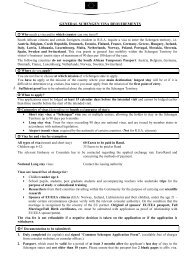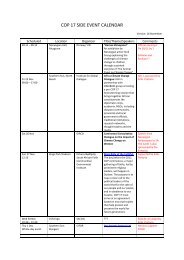Environmental impact management and planning: - Norway
Environmental impact management and planning: - Norway
Environmental impact management and planning: - Norway
You also want an ePaper? Increase the reach of your titles
YUMPU automatically turns print PDFs into web optimized ePapers that Google loves.
Law reform: amending NEMA <strong>and</strong> the EIA regulationsPurpose: To develop a robust environmental <strong>impact</strong><strong>management</strong> system that caters for tools other than justenvironmental <strong>impact</strong> assessment.OverviewThe law reform programme for environmental assessmentenabled the streamlining of environmental assessmentlegislation <strong>and</strong> associated administrative procedures,which were geared towards improved environmental<strong>impact</strong> <strong>management</strong>. This contributed to the sustainabledevelopment of natural <strong>and</strong> cultural resources, <strong>and</strong>facilitated the improvement of environmental quality. Thissubproject focused on ensuring that NEMA contained thenecessary enabling provisions <strong>and</strong> that effect is given toa strong <strong>and</strong> robust EIA system through amendments tothe EIA regulations.ProgressThe new EIA regulations were promulgated on21 April 2006 <strong>and</strong> came into effect on 3 July 2006 forall listed activities except mining activities, which arestill governed by the Mineral <strong>and</strong> Petroleum ResourcesDevelopment Act, 2002 (Act No 28 of 2002) (MPRDA).The preparations for the implementation of thenew regulations were completed <strong>and</strong> included thedevelopment of guidelines <strong>and</strong> templates, as well asconducting introductory training courses <strong>and</strong> informationsessions in all provinces.The draft regulations had to be published twice for publiccomment. Details such as the listing of mining <strong>and</strong>the conflicting m<strong>and</strong>ates of government departmentsrequired extensive consultation with the relevant authorities,which also caused delays in finalising the regulations.The fact that these regulations have to meet the needsof ten different autonomous authorities (the nationalDepartment of <strong>Environmental</strong> Affairs <strong>and</strong> the nine provincialdepartments responsible for environmental <strong>management</strong>in each province), all with their own priorities <strong>and</strong> needs,complicated the drafting process tremendously, becauseconsensus had to be reached on a lot of issues where therewere differences of opinion.As the EIA regulations are administered by the DEA <strong>and</strong>the nine provincial environmental authorities, it is essentialthat new legislation <strong>and</strong> associated activities continue tobe developed as a joint venture between the DEA <strong>and</strong>the provinces. Close technical cooperation with all theprovinces <strong>and</strong> enhanced cooperation with relevant nationaldepartments were achieved during the drafting process.BenefitsThe ultimate aim is to have a robust EIM system in SouthAfrica that also caters for other tools to be used to achieveintegrated environmental <strong>management</strong>. The latest NEMAAmendment Act provides for such an approach, whichwill now have to be elaborated upon <strong>and</strong> implemented. Amore focused approach on those development activitiesthat require EIAs should also lead to the EIA adding muchmore value to decision-making <strong>and</strong> proper environmental<strong>management</strong>. The development of other tools such asnorms <strong>and</strong> st<strong>and</strong>ards for certain other developmentactivities will ensure that the best method of achievingproper environmental <strong>management</strong> is used.Possible further workFurther amendments have been made to NEMA. This cameinto effect on 1 May 2009. This Amendment Act contains anumber of new provisions, including provisions for integratedenvironmental authorisations, <strong>and</strong> a number of provisionsspecifically incorporated from the MPRDA to cater for miningactivities. The development of an integrated permittingsystem that can combine EIA authorisations, waste permits<strong>and</strong> air quality permits is a high priority.4







